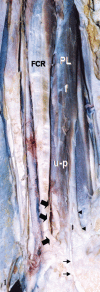Fleshy palmaris longus muscle - a cadaveric finding and its clinical significance: a case report
- PMID: 23935323
- PMCID: PMC3738618
Fleshy palmaris longus muscle - a cadaveric finding and its clinical significance: a case report
Abstract
Introduction: Palmaris longus variations may include complete agenesis, variation in the location and form of the fleshy portion, aberrancy in attachment, duplication or triplication, accessory tendinous slips, replacing elements of similar form or position. Description of case: An anomalous palmaris longus muscle was found in the right upper extremity of a 63 year-old male cadaver. The muscle was totally fleshy without a long insertion tendon. Its origin was normal, the belly was rather broad and long, fusiform at the upper half and unipennate at the lower half of the forearm, and it was toggled into a short and thick tendon. At its insertion the tendon was split forming a second thinner tendon. The thick tendon was inserted into the flexor retinaculum and the thinner one into the palmar aponeurosis. The muscle compressed the median nerve although no related symptoms were reported on the cadaver's medical history.
Discussion: This variation is of clinical importance because it may cause carpal tunnel syndrome or difficulties in image interpretation by radiologists. In addition the palmaris longus muscle is an anatomical landmark for operations at the forearm and wrist and its tendon can be used as a graft.
Keywords: anatomical variations; forearm; hypertrophy; muscle variations.
Figures


References
-
- Natsis K, Levva S, Totlis T, Anastasopoulos N, Paraskevas G. Three-headed reversed palmaris longus muscle and its clinical significance. Ann Anat. 2007;189:97–101. - PubMed
-
- Paraskevas G, Tzaveas A, Natsis K, Kitsoulis P, Spyridakis I. Failure of palmaris longus muscle duplication and its clinical application. Folia Morphol (Warsz) 2008;67:150–153. - PubMed
-
- Reimann A, Daseler E, Anson B, Beaton L. The Palmaris longus muscle and tendon. A study of 1600 extremities. Anat Rec. 1944;89:495–505.
-
- Acikel C, Ulkur E, Karagoz H, Celikoz B. Effort-related compression of median and ulnar nerves as a result of reversed three-headed and hypertrophied palmaris longus muscle with extension of Guyon's canal. Scan J Plast Reconstr Surg Hand Surg. 2007;41:45–47. - PubMed
-
- Bencteux P, Simonet J, el Ayoubi L, Renard M, Attignon I, Dacher JN, et al. Symptomatic palmaris longus muscle variation with MRI and surgical correlation: report of a single case. Surg Radiol Anat. 2001;23:273–275. - PubMed
Publication types
LinkOut - more resources
Full Text Sources
